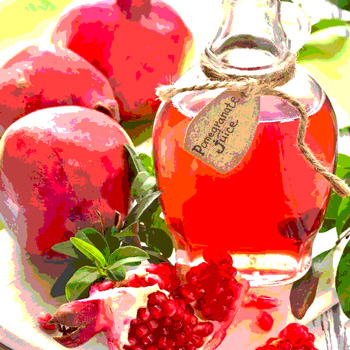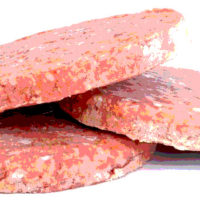Pomegranate Juice Adulteration

Pomegranate juice’s popularity has skyrocketed in the last 10 years. This has been due to a combination of the perceived health benefits of consuming the juice’s various antioxidant compounds (punicalagin, anthocyanins and ellagic acid) and its increased mainstream availability through Western pomegranate producers. This increase is highlighted by the rise in the consumption of 8-ounce servings of pomegranate juice in the U.S., which went from 75 million servings in 2004 to 450 million servings by 2008.[1] Interestingly, there data indicate that in 2004, there was a 50:50 pure:blended pomegranate juice consumption, whereas in 2008, 100% pomegranate juice made up 75% of that consumed.[1] Popular juice blends, such as apple and grape, are less bitter and can make the overall juice taste more pleasant to those new to pomegranate. These blends have an additional advantage of being cheaper than pure pomegranate juice. Whereas a gallon of pomegranate juice concentrate costs $30–60, a gallon of apple or grape juice is between $5–7. This means if a pomegranate juice product is labeled as a blend with apple and grape juice, the consumer can expect to pay less than the cost of pure pomegranate juice.
Problems occur when lower-cost juices are added and are not mentioned on the label. This means that a producer can charge $30–60 for a gallon that is only worth $10–20. When asking how this happens, first consider where pomegranates have traditionally been grown. Iran is one of the world’s largest producers; however, other notable countries include Iraq, Syria, Afghanistan, Armenia, Georgia, Azerbaijan and many more. The countries have all had problems with suspicious food products in the past, with recent data suggesting a very high percentage of adulterated pomegranate juice is coming from the region. The question should then arise ‘why not flag these countries imports into the West as suspicious?’ This scheme should be effective, but unfortunately, the food supply chain is very complex. For example, these juices may be shipped to a distributor in India or China or Russia, before being shipped to the West for bottling and consumption with virtually no trace of the original grower. As such, some final products maybe adulterated without the final the bottler’s knowledge.
How can we detect this?
 While traceability is still an issue, detection of these fraudulent juices is important. Chromatography combined with mass spectrometry (MS) has been used to detect marker compounds for both pomegranate and the adulterant juices to good effect.[2] The issue with these techniques is that they require a certain amount of sample preparation before analysis and the chromatography process itself can take up to an hour. The AxION Direct Sample Analysis (DSA) system integrated to the AxION 2 Time of Flight (TOF) MS allows for the direct ionization and detection of the juice in seconds without sample preparation or method development. This not only speeds up the analysis to less than 10 seconds, but it also means that non-scientists can test for adulteration without the need to understand the fundamental chemistry. Figure 1 shows the mass spectral profiles of 1a: pomegranate juice, 1b: grape juice and 1c: pomegranate juice, with 1% grape juice adulteration carried out on a PerkinElmer AxION® DSA/TOF MS system with juice pipetted directly onto steel mesh for analysis, with gas temperature (25°C), flow rate (3 L/min) and capillary exit voltage (-100 V) previously adjusted to maximize signal, giving an average mass accuracy of less than 5 ppm. Figure 1a shows that there are significant contributions from citric and malic acid in pomegranate juice, Figure 1b shows that grape juice also has malic and citric acids but also a contribution from tartaric acid. As this is not present in pomegranate, this means tartaric acid can be used as a marker for grape juice addition to pomegranate juice. This is supported by Figure 1c where 1% grape juice has been added to pomegranate juice and the tartaric is still clearly viable. Hence, the juice is shown to be adulterated (with grape or another tartaric acid-containing fruit juice).
While traceability is still an issue, detection of these fraudulent juices is important. Chromatography combined with mass spectrometry (MS) has been used to detect marker compounds for both pomegranate and the adulterant juices to good effect.[2] The issue with these techniques is that they require a certain amount of sample preparation before analysis and the chromatography process itself can take up to an hour. The AxION Direct Sample Analysis (DSA) system integrated to the AxION 2 Time of Flight (TOF) MS allows for the direct ionization and detection of the juice in seconds without sample preparation or method development. This not only speeds up the analysis to less than 10 seconds, but it also means that non-scientists can test for adulteration without the need to understand the fundamental chemistry. Figure 1 shows the mass spectral profiles of 1a: pomegranate juice, 1b: grape juice and 1c: pomegranate juice, with 1% grape juice adulteration carried out on a PerkinElmer AxION® DSA/TOF MS system with juice pipetted directly onto steel mesh for analysis, with gas temperature (25°C), flow rate (3 L/min) and capillary exit voltage (-100 V) previously adjusted to maximize signal, giving an average mass accuracy of less than 5 ppm. Figure 1a shows that there are significant contributions from citric and malic acid in pomegranate juice, Figure 1b shows that grape juice also has malic and citric acids but also a contribution from tartaric acid. As this is not present in pomegranate, this means tartaric acid can be used as a marker for grape juice addition to pomegranate juice. This is supported by Figure 1c where 1% grape juice has been added to pomegranate juice and the tartaric is still clearly viable. Hence, the juice is shown to be adulterated (with grape or another tartaric acid-containing fruit juice).
Is there an alternative technique?
 DSA/TOF MS is a relatively simple, quick technique to carry out an accurate analysis of pomegranate juice adulteration but most cases of adulteration are in larger percentages. Given this, can we use a screening technique so that all samples can be scanned in an effective, yet efficient way? One possible technology that has been investigated is UV/Vis spectroscopy.[3] For this work, 27 pomegranate, apple and grape mixtures were measured undiluted in 1-mm reduced path length cuvettes (as the samples absorb strongly, a 10-mm cuvette would be unsuitable) using a PerkinElmer LAMBDA™ 25 UV/Vis spectrometer with a fixed 1-nm bandpass and a 0.1-nm data interval (in order to produce as many data points as possible for the chemometric analysis), with the resulting second derivative spectra shown in Figure 2a, pure pomegranate shown in Figure 2b, pure apple in Figure 2c and grape in Figure 2d. Second-derivative spectroscopy is a useful tool when measuring natural products as it tends to be less susceptible to non-specific background absorbance effects while, in this particular case, enhancing peaks of analytical interest. Most mixtures, Figure 2a, show two significant features—a feature at 530 nm that is seen in pomegranate (Figure 2b) and grape (Figure 2d). This is due to the red color of both pomegranate and grape juice and is not surprising that apple juice has no observed feature. The spectra in Figure 2b also reveal features in the UV region for pomegranate juice that were present in all pomegranate-containing mixtures. These features are primarily due to the contributions from antioxidant compounds[4] such as ellagic acid and give us a positive marker for pomegranate.
DSA/TOF MS is a relatively simple, quick technique to carry out an accurate analysis of pomegranate juice adulteration but most cases of adulteration are in larger percentages. Given this, can we use a screening technique so that all samples can be scanned in an effective, yet efficient way? One possible technology that has been investigated is UV/Vis spectroscopy.[3] For this work, 27 pomegranate, apple and grape mixtures were measured undiluted in 1-mm reduced path length cuvettes (as the samples absorb strongly, a 10-mm cuvette would be unsuitable) using a PerkinElmer LAMBDA™ 25 UV/Vis spectrometer with a fixed 1-nm bandpass and a 0.1-nm data interval (in order to produce as many data points as possible for the chemometric analysis), with the resulting second derivative spectra shown in Figure 2a, pure pomegranate shown in Figure 2b, pure apple in Figure 2c and grape in Figure 2d. Second-derivative spectroscopy is a useful tool when measuring natural products as it tends to be less susceptible to non-specific background absorbance effects while, in this particular case, enhancing peaks of analytical interest. Most mixtures, Figure 2a, show two significant features—a feature at 530 nm that is seen in pomegranate (Figure 2b) and grape (Figure 2d). This is due to the red color of both pomegranate and grape juice and is not surprising that apple juice has no observed feature. The spectra in Figure 2b also reveal features in the UV region for pomegranate juice that were present in all pomegranate-containing mixtures. These features are primarily due to the contributions from antioxidant compounds[4] such as ellagic acid and give us a positive marker for pomegranate.
 This means that UV/Vis spectroscopy can be used, by measuring the loss of absorbance in this region, as an indication of the extent to which the pomegranate juice has been adulterated. Alternatively, it could be used as a check for juice blends that the correct pomegranate, apple and grape ratios are present, as shown in Figure 3a, which is a quantitative fit to the data that shows excellent straight-line correlation. From this fit, it is shown in Figure 3b that for unknown mixtures of the juices, the ratios can be calculated.
This means that UV/Vis spectroscopy can be used, by measuring the loss of absorbance in this region, as an indication of the extent to which the pomegranate juice has been adulterated. Alternatively, it could be used as a check for juice blends that the correct pomegranate, apple and grape ratios are present, as shown in Figure 3a, which is a quantitative fit to the data that shows excellent straight-line correlation. From this fit, it is shown in Figure 3b that for unknown mixtures of the juices, the ratios can be calculated.
Conclusions
This work has shown that monitoring of incoming juices does not need to be difficult, time consuming or expensive with testing technologies such as DSA/TOF MS and screening technologies such UV/Vis spectroscopy. Detection technologies such as these will be essential in ensuring that the food and beverage products that are being imported are both safe and authentic. However, it will ultimately be when these technologies are linked to traceability software, allowing electronic tracking from the source, that the criminals will be dissuaded from adulterating products and detection evolves into prevention.
References
1. Roberts, M.T. (2011) History of pomegranate juice adulteration. Intentional and Unintentional Adulteration of Food Ingredients and Dietary Supplements. USP workshop, Baltimore, USA.
2. Krueger, D.A. (2012) Composition of pomegranate juice. J AOAC Int 95(1):163–168.
3. Boggia, R. et al. (2012) A rapid method to assess authenticity of “100% pure” pomegranate juices by UV/Visible spectroscopy and multivariate analysis. J Food Agric in press.
4. Gil, M. (2000) Antioxidant activity of pomegranate juice and its relationship with phenolic composition and processing. J Agric Food Chem 48:4581–4589.
For more information, please visit www.perkinelmer.com.
Looking for a reprint of this article?
From high-res PDFs to custom plaques, order your copy today!



